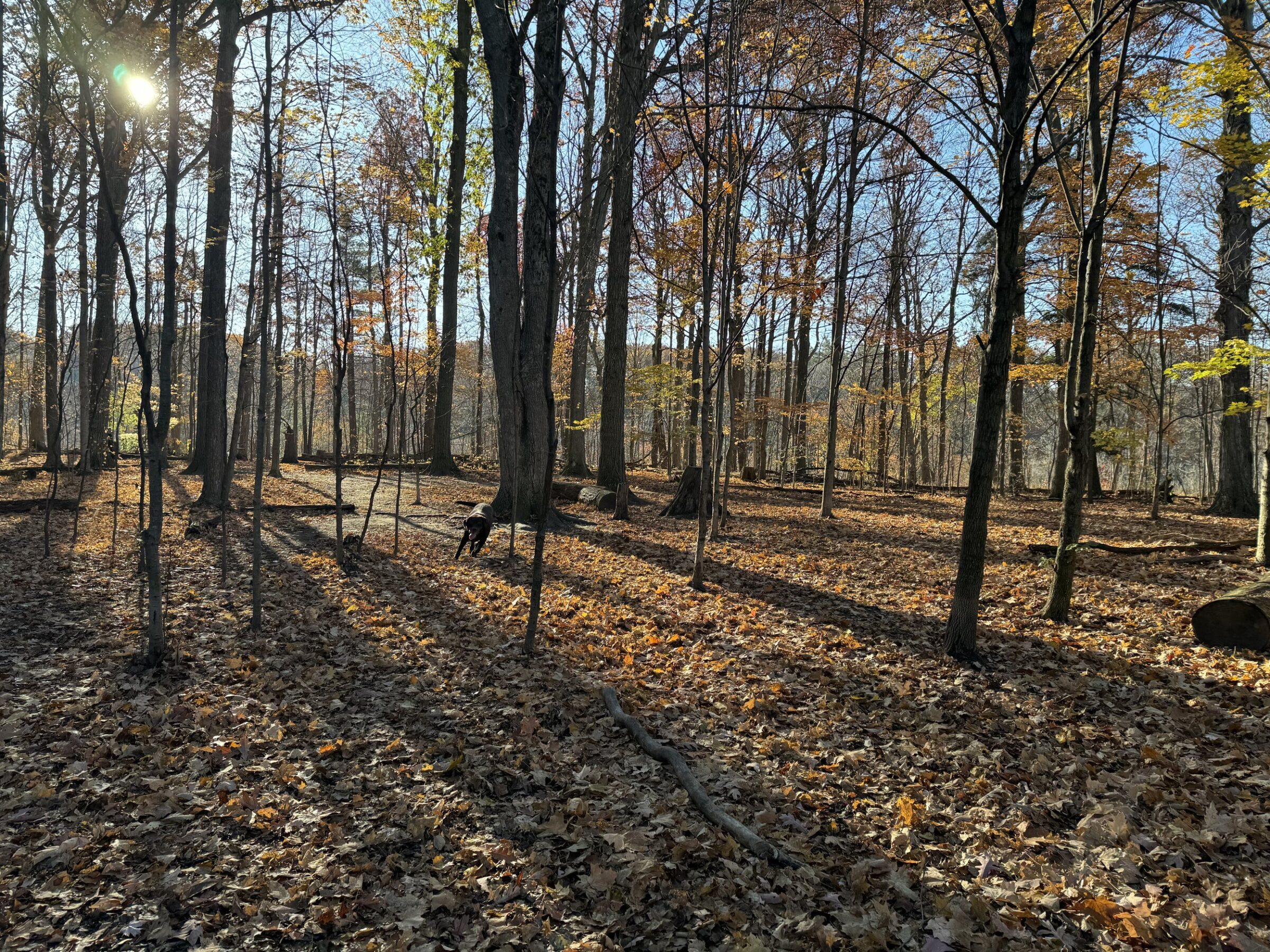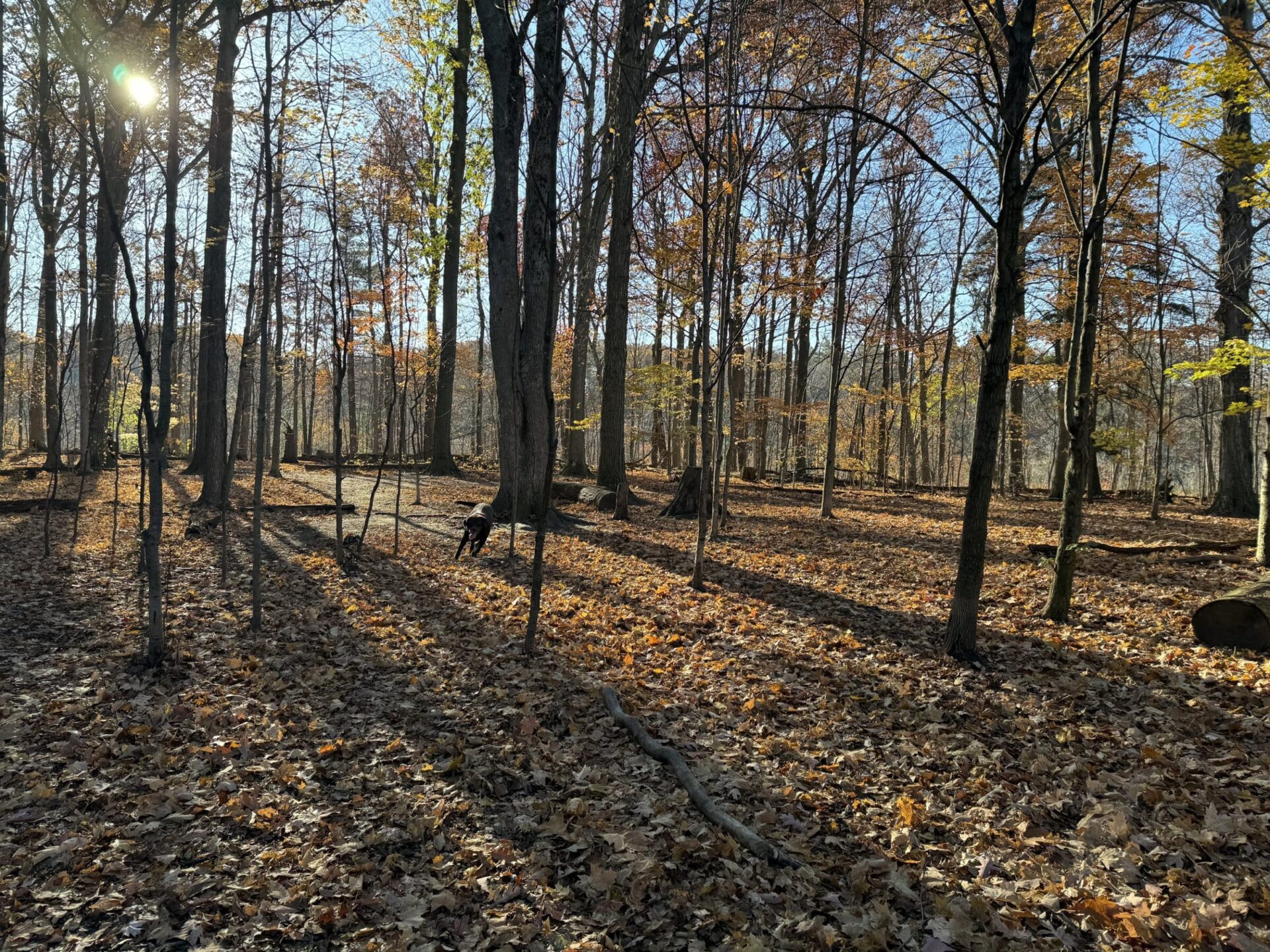Dogs & Athletes – a Mental Construct towards embracing your “Thrive Zone”

Nov. 7
Written By Heather Buckle
Have you been out for a walk in nature lately? Even better, a walk with your dog (or a friends dog 🙂 out in nature? If not, I highly recommend it… not just for the fresh crisp air and the exercise, but because taking in the surroundings of the fall can be very enlightening.

Where’s Waldo? Find Tobie, the 88 year old Chocolate Lab who challenged
my construct on pain today 🙂
I watched my 11 year old labrador retriever running joyfully through the leaves and trails this week. In dog years, this adorable companion is 88 years old. And he has a completely ruptured ACL in one knee from an old injury in his younger years (that we opted to rehab instead of surgery, which gratefully we had the skillset to do), in addition to bilateral hip arthritis and cataracts. This beautiful furball of mine has numerous physical challenges that could rightfully limit him. (Disclaimer: The concepts within do not constitute medical advice and should not be considered applicable without exceptions, however, stick with me to see if todays “aha moment” might help you in your journey.)
I had a thought – if my labrador retriever were a human, would he be more limited from these injuries, more constrained and more subdued because of them? Is he joyfully mobile because as a dog , he is protected from the idea that maybe he should feel miserable and lay low? Or is it because he is missing the “fear of pain” and “fear of consequences” that us humans experience? I note – yes, there are conditions and timings in those conditions when rest or relative rest are advised so please seek your Physiotherapists or Physicians advice pertaining to your condition. BUT in a large proportion of injuries and conditions, science tells us that tissue needs to be challenged in order to recover. We see this again and again in research and clinically. Athletes often thrive in rehab because they are comfortable with pushing themselves and have pushed their tissues past the limit of what is considered ideal many times in life in order to discover their “thrive zone” if you will, the zone of intense tissue challenge where it’s uncomfortable but they feel confident that its where they need to be to grow, get stronger, faster, heal and progress. They know that zone because they’ve also discovered the “tipping Point” or the “tissue fail zone” many times where they either have pain for a few days, weeks or even an injury. But it was those experiences that lead an athlete to be able to rehab so well – because they’ve already discovered their failure point. repeatedly They trust their body’s instincts and are confident in how much discomfort is just enough and when to know to step back and re-evaluate. Dogs are like athletes. (aside: maybe not all breeds? Labrador Retrievers and
Bernese Mountain dogs are most definitely like athletes :).
I’ve watched my Bernese dog Theo run down a steep hill that was about to take a fast change in direction uphill, and it felt like slow motion as I prayed he’d slow down but as he approached it, he was jowls flapping, joyfully bounding from the steep decline into a wall that was the fast incline. He hit with a thud, snowball rolled 5 times very awkward with legs in all directions, I lost sight of him in the mini dip so I was running to his rescue as I see him leap over the blind hill towards me with the hugest smile. As a human, I feel our instinct would be to evaluate all body parts carefully as we rise. slowly because of our knowledge that we should. It’s because our brains know too much, we over evaluate, over think, over speculate what we may have hurt or what might hurt tomorrow. It’s that knowledge base that truthfully will help us in many cases but in many cases, it will also be our downfall.
I’ve also watched my 11 year old lab Tobie try to leap over a 4 foot high fallen tree log (that he could have gone UNDER:), after he had already leapt many 2 and 3 ft fallen logs successfully and was now warmed up and felt confident. He plowed into it, fell backwards, and I’m almost certain I caught an embarrassed grin and a dimple from him as he leapt up and tried again. And again. Still knowing he could go under it but he wanted to go OVER it. And when he was successful on the 5th try, he was so joyful at his success he shared his glee with a display of the “zoomies” around the trees. Encountering failure is a necessity to success. We all know that. Trying again and again is the ONLY way we discover what we are truly capable of. As humans, we have a cognitive response to injury or pain, one that tells us to not do that again and in many cases, to over compensate and change our behaviours to prevent putting ourselves even in the near vicinity of that risk again.
Watching my 88 year old senior dog this week joyfully agile and mobile, it made my heart warm. Was he limping at the start? A little. Was he limping mid run? Barely. Was he limping at the end? For sure. Did he want to keep going and not go back to the car despite the limp? Absolutely! He was so joyfully alive and would show his gratitude during and after the walk in all the beautiful ways dogs do. When it came time to get into the car? I offer to lift him into our SUV since he’s tired (it’s a good 3-4 ft jump as well – we’ve tried ramps for him before but he refuses to use them). Tobie steps back, to say “no thank-you”, so I coax him gently saying “let me help you, you’re tired”, but he makes himself rigid and impossible to pick up. I see the look in his eyes. I know it all to well and understand him completely. It’s not pride for him – it’s his own sense of self capability. He wants to jump in the car and repeatedly refuses my help. Neighboring vehicles at the leash-free dog trail head are now paused and watching this entertaining show. One gentleman laughs and comments on his grit. He makes a few mini run attempts but last minute stops himself cause he knows his speed or angle aren’t quite right. He backs up to try again. And again. I offer help again. He backs up again. This time he gets his calculations spot on and he makes the leap gracefully and made it look effortless. This is with no ACL on one leg, hip arthritis and cataracts at age 88. And the next morning, he wakes stiff and slow moving as per usual because that’s the body he has but yet he eagerly greets me, begging for another trail run or walk. He has discovered through repeat experiences that even when he hurts, he feels better during and after the run and it brings him joy. Endorphins are real. The blood rush and circulation boost to his muscles and heart is real. The boost to his joint lubrication and mobility is real. And even though his pain too is real, he has discovered a joy in this activity and exercise that offsets that for him.
This blog is not to encourage unsafe or painful activities – please proceed with safety and awareness matched to your abilities and inabilities. I only hope anyone reading can extract from the above stories and analogies a construct that is suitable and inspirational to your own journey in life. Dogs and Athletes are alike in so many beautiful ways and I only hope that we can all allow ourselves to self-reflect on ways we can improve our very own mental game plan and possibly fine tune it on occasion to allow ourselves more opportunity for growth and success, not just in rehab or sports, but in life.
